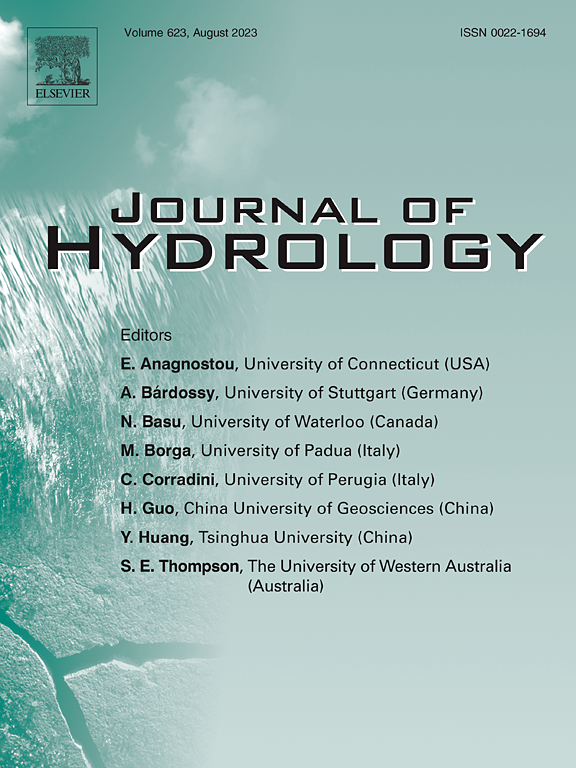中巴经济走廊融雪洪水变化及驱动因素分析
IF 5.9
1区 地球科学
Q1 ENGINEERING, CIVIL
引用次数: 0
摘要
洪灾是中巴经济走廊沿线最常见的灾害之一,具有高度危险性和破坏性,严重阻碍了区域社会经济发展。采用块最大值(Block Maximum, BM)模型和峰值超过阈值(Peak Over Threshold, POT)模型分析了1948—2022年中巴经济走廊喀什河流域和印度河流域融雪洪水的时空特征。基于主成分分析和k-means聚类算法对历史洪水进行分类。利用Spearman等级相关系数和随机森林模型对融雪洪水的主要气候因子进行了分析。结果表明:两流域共发生融雪洪水85次和93次,主要发生在春季(3 ~ 5月)。喀什噶尔河流域融雪洪水发生提前,印度河流域融雪洪水发生推迟。在喀什噶尔河流域和印度河流域分别确定了5个和4个洪水等级。归因分析表明,积雪因子是关键的先决条件,特别是14天前最大SWE (MSWE)。喀什噶尔河流域对1982 ~ 1999年7日累积降水(CPr7)较为敏感,而对2000 ~ 2020年7日累积平均气温(TEMP7)较为敏感。1982 ~ 1999年,印度河流域对1日累积降水(CPr1)更为敏感。2000 ~ 2020年,CPr7对融雪洪水的影响呈增加趋势。该研究为中巴经济走廊地区融雪洪水预报和预防以及区域防灾减灾工作提供了科技支撑。本文章由计算机程序翻译,如有差异,请以英文原文为准。
Changes in snowmelt flooding and driver factors in the China-Pakistan Economic Corridor
Flooding is one of the most frequent disasters in the China-Pakistan Economic Corridor (CPEC), which is highly dangerous and destructive, and seriously hinders regional socio-economic development. In this study, the Block Maximum (BM) model and the Peak Over Threshold (POT) model were used to analyze the spatial and temporal characteristics of snowmelt floods in the Kashgar River Basin and the Indus River Basin of CPEC during 1948–2022. Historical floods were classified based on principal component analysis and the k-means clustering algorithm. The main climatic factors of snowmelt floods were analyzed using Spearman’s rank correlation coefficient and random forest model. The results indicated that 85 and 93 snowmelt flood events occurred respectively in the two basins, mainly in spring (March–May). The occurrence of snowmelt floods was advanced in the Kashgar River Basin, while that in the Indus River Basin was delayed. Five and four flood classes were identified in the Kashgar River Basin and the Indus River Basin, respectively. Attribution analysis suggested that the snow factors are key preconditions, especially the 14-day antecedent maximum SWE (MSWE). The Kashgar River Basin was more sensitive to 7-day cumulative precipitation (CPr7) from 1982 to 1999, but to 7-day cumulative daily average temperature (TEMP7) from 2000 to 2020. The Indus River Basin was more sensitive to 1-day cumulative precipitation (CPr1) from 1982 to 1999. However, the impact of CPr7 on snowmelt floods increased from 2000 to 2020. The study provides scientific and technological support for snowmelt flood forecasting and prevention in CPEC and regional disaster prevention and mitigation efforts.
求助全文
通过发布文献求助,成功后即可免费获取论文全文。
去求助
来源期刊

Journal of Hydrology
地学-地球科学综合
CiteScore
11.00
自引率
12.50%
发文量
1309
审稿时长
7.5 months
期刊介绍:
The Journal of Hydrology publishes original research papers and comprehensive reviews in all the subfields of the hydrological sciences including water based management and policy issues that impact on economics and society. These comprise, but are not limited to the physical, chemical, biogeochemical, stochastic and systems aspects of surface and groundwater hydrology, hydrometeorology and hydrogeology. Relevant topics incorporating the insights and methodologies of disciplines such as climatology, water resource systems, hydraulics, agrohydrology, geomorphology, soil science, instrumentation and remote sensing, civil and environmental engineering are included. Social science perspectives on hydrological problems such as resource and ecological economics, environmental sociology, psychology and behavioural science, management and policy analysis are also invited. Multi-and interdisciplinary analyses of hydrological problems are within scope. The science published in the Journal of Hydrology is relevant to catchment scales rather than exclusively to a local scale or site.
 求助内容:
求助内容: 应助结果提醒方式:
应助结果提醒方式:


